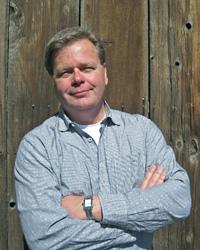Randy Sater

Randy Sater has worked for Teichert Mining Company for many years by running their real-estate development program, Stonebridge Properties. Part of his job entails looking for ways to give back to the communities in which Teichert has operated. One particular example of this community outreach program is Teichert’s involvement in the Cache Creek Nature Preserve.
In 1998 Sater was actively involved with the mining operations in Yolo County. At that time, the land that is now the Cache Creek Nature Preserve was owned by Teichert and permitted for mining. However, due to the variety of habitats and animals on the land, Teichert felt that this was a site that was not appropriate to mine. They decided that the right thing to do would be to donate the property to the County and establish a conservancy that would maintain it in perpetuity. As the liaison between Teichert and the Conservancy, Sater worked with the farming community, environmental community, and the general public to develop and establish a plan for the preservation of Cache Creek.
Describe where we are and what’s around us right now.
Right now we happen to be in the Jan T. Lowrey Memorial Grove. Jan T. Lowrey was actively involved—just fundamentally instrumental to the development of this nature preserve. Jan was originally on the Board of the Cache Creek Conservancy and later became its Executive Director. I worked side by side with Jan for probably 2 years after we donated the property to the County of Yolo developing a master plan or a conceptual plan about how the site would be laid out. Jan was the man who was instrumental for making that all happen. He oversaw the construction of the overlooks, the trails and peninsulas, and the habitat restoration.
Tell us about how working for Teichert has influenced your involvement in the preserve.
My background isn’t in biology or environmental studies or ecology. My background is in real estate development. But when you start working for a mining company and are involved with obtaining the land use entitlements, one of the things you find out is that you very quickly become familiar with, and sometimes an expert in, biology and environmental science and ecology. The more time I spent and walked around this site, I realized it’s just a great place—with the running water, the creek, the animals and the habitat—it’s just a great place to collect your thoughts.
Does Teichert, at this point, have anything to do with the Preserve anymore or did they just donate the land?
I was also involved with the establishment of the Cache Creek Conservancy. And the Conservancy board is made up of representatives from the aggregate industry, of which Teichert is a member, as well as farmers, environmentalists and citizens of Yolo County. The aggregate industry pays 10 cents a ton (of gravel sold in Yolo County), and that goes to the Cache Creek Conservancy. That’s an important point to all of this: there is a sustainable funding mechanism to help keep the Cache Creek Nature Preserve and the Conservancy activities going.
Tell us about some kind of activity that you were involved with; some project that you had to do…
We took a community-based approach to developing this nature preserve that started around a table over at our construction trailer at the aggregate plant across the creek. We invited people from the community, farmers, environmentalists, local government, to sit around a table and talk about what could this really become. And we wanted to make sure that we preserved the habitat, but we also wanted to make sure that this was a place that school children could come or folks from the university can come: a place people who don’t really have the opportunity to come in contact with nature or with the creek in Yolo County can come to and experience. We met on this project probably the better part of a year…just planning it. And so the event that I remember was the day that we opened it to the public and we had kind of a ribbon cutting, if you will, and invited the community to join us. We probably had about 500 people here that day. It was just really rewarding because this was an idea that we worked on for 2 or 3 years: pulling it together, working out the agreements with the County, working out the agreements with the Cache Creek Conservancy. That day was just really rewarding, just really, really exciting.
How has the preserve impacted you or your family or people you know?
I think you can’t help but be involved in a project like this and develop a sense of community. I’m not talking about a community like the neighboring communities of Woodland or Davis or Capay. What I’m talking about is a community of people that came together and still come together on a weekly basis that enjoy this place. Just today, coming out here and seeing Lynnel Pollock again and getting a big hug even though I haven’t seen her in quite a while, it’s just a great thing; it’s a great experience. We connected immediately, bonded over this project. Friendships were made, children were born, children have grown up here, good friends have passed away that were involved in this project. It’s about nature, but it’s also about human contact with nature. It’s about building community. From that perspective, I think that it will live on forever, and that’s pretty cool.
To download the audio, right click on the audio link above and scroll to "Save link as . . ." and choose the directory where you want to store the mp3. In Windows, you may have to use Control + S to select the link.